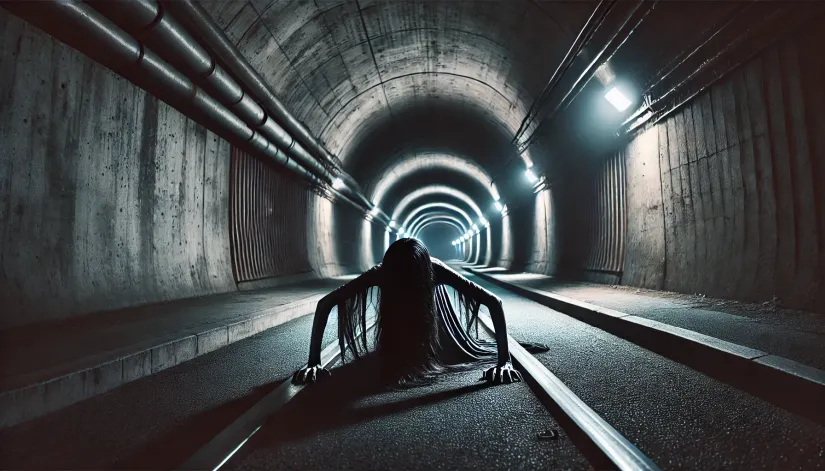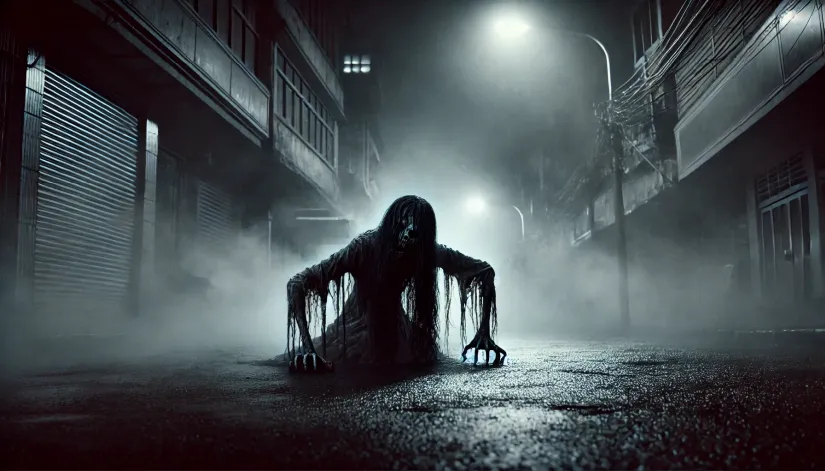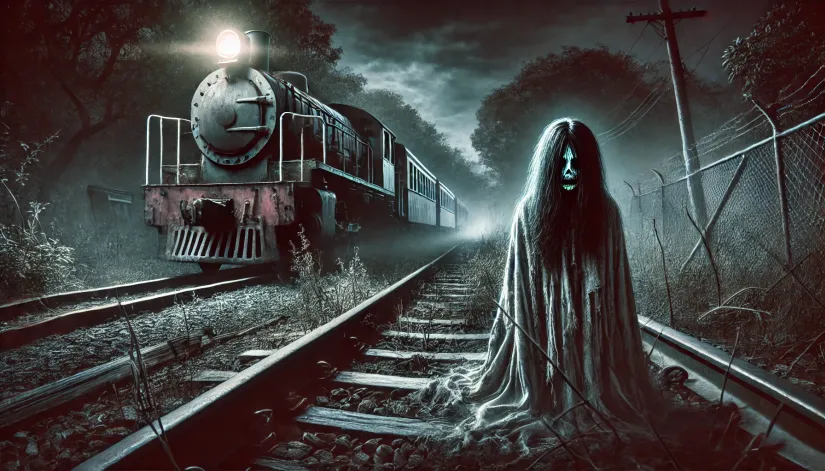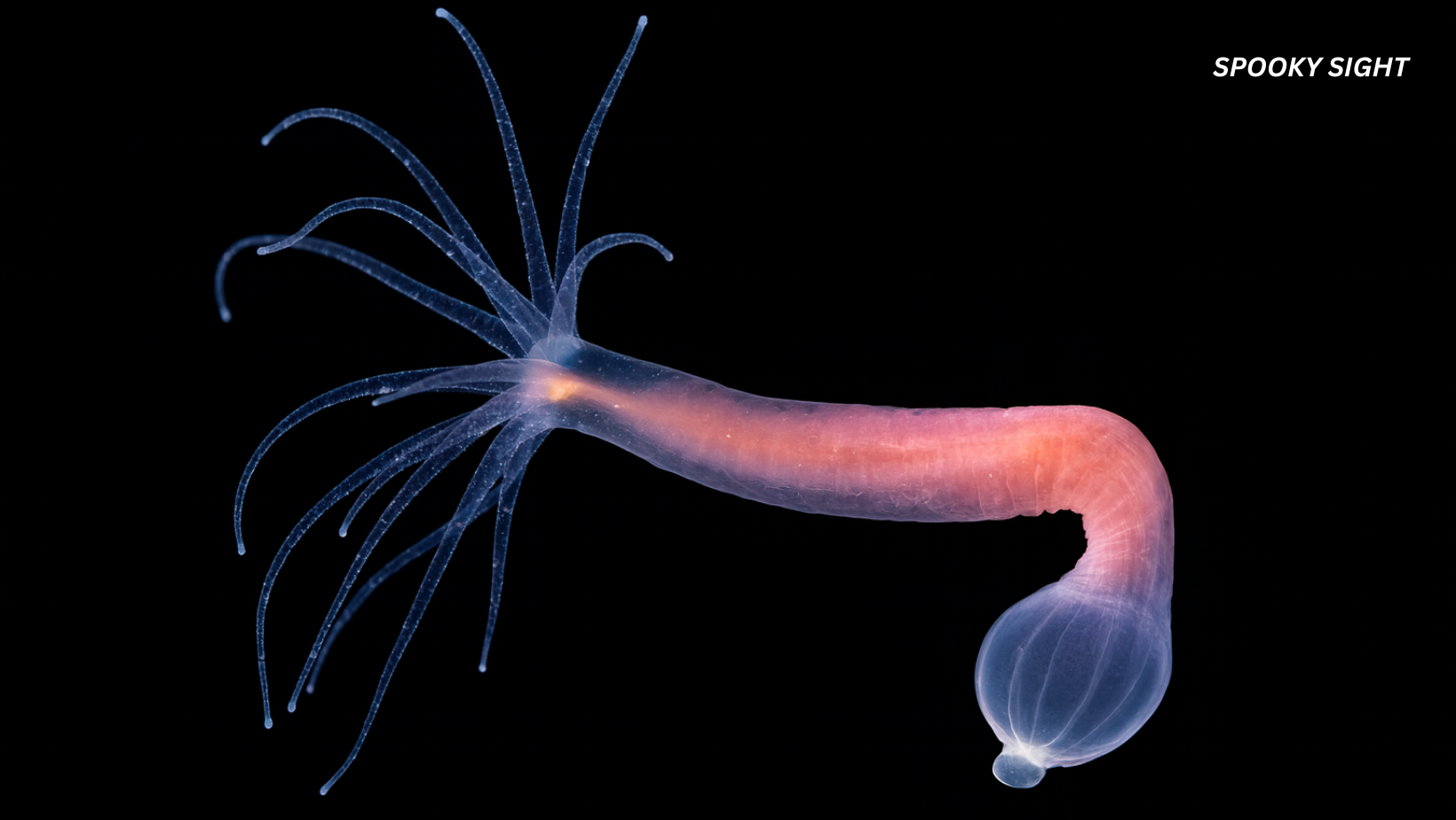What happens when you hear a strange, dragging sound near a train station late at night? In Japan, some claim it could be something far more terrifying than a passing noise.
According to one of Japan’s most terrifying urban legends, the chilling sound is made by a ghost—a vengeful spirit severed in half—that tracks down its unsuspecting victims. Its movements are marked by the haunting “teke-teke” sound it makes.
So, what exactly is this “Teke Teke” Japanese urban legend? And what should you do if you ever hear the strange “teke teke” sound? Can you even outrun the spirit? Or when you hear that telltale noise, it’s already too late?
In this article:
What is the Teke Teke Japanese Monster?
The Teke Teke is one of the scariest Japanese urban legends and horror stories. The monster is, in fact, a vengeful spirit—a girl cut in half by a train—who now haunts urban areas and train stations.
Yep, you read that right. She’s a ghost without legs, dragging herself using her hands or elbows. The eerie sound she makes? That’s the “teke-teke” or “click-clack” sound, echoing as she moves.
And don’t be fooled. She may not have a lower body… but she’s incredibly fast. If you cross her path, well, let’s just say you don’t wanna stick around to find out what happens next.
This ghost is often linked to tragic train accidents.

The Origins of the Urban Legend
Already scared? There’s a lot more to this Japanese urban legend. But a good starting point to learning more about this monster is the two “origin” stories:
The Bullied Schoolgirl
So, here’s the deal. There are two main versions of how Teke Teke came to be. Both are equally unsettling.
The first tells the story of a bullied schoolgirl named Kana. She was timid and often picked on by her classmates—the target of cruel jokes and pranks. The quiet, introverted girl had no one to defend her.
One day, the bullying reached a horrific climax. Her classmates decided to play a particularly cruel prank using a cicada—a large insect that Kana was terrified of. This last prank was more than she could handle. And, in the chaos that followed, she somehow ended up on the train tracks.
Some versions say she was accidentally pushed by her tormentors. Others suggest that she stumbled and fell on her own.
Unable to escape in time, the girl was tragically cut in half by a speeding train. Her spirit (filled with rage and sorrow) became the deadly Teke Teke ghost, forever haunting the places where she suffered.
The Post-War Office Worker
The second version of the Teke Teke urban legend centers around a post-war office worker named Sachiko. This variant is set in the turbulent years following World War II.
One evening, Sachiko was returning home late after an exhausting day at the office. But it was rush hour already. Thousands of people in the train station waiting for their connection.
Whether due to fatigue, distraction, or perhaps the overwhelming crush of people, Sachiko lost her balance. She fell onto the tracks just as a train was approaching.
Before anyone could react or come to her aid, the train barreled through the station, severing her body in two. The woman died instantly. But her spirit was not at peace.
Legend has it that her soul became vengeful and full of despair. Her anger and sorrow transformed her into the Teke Teke monster—a dismembered spirit that haunts the very place where she met her grisly end.
What’s interesting about both these origin stories is that the turmoil and rapid changes during Japan’s post-war industrialization created the perfect set for such accidents to happen. And they did happen.
Train crashes, derailments, and other accidents resulted in significant fatalities and injuries during the 1950s and the 1960s.
For instance, the Mikawashima train crash in 1962 caused 160 deaths and nearly 300 injuries, one of the deadliest accidents in Japan’s rail history. Another major accident was the Yokohama train crash just 18 months later, which claimed 162 lives.
Between 1955 and 1964, Japan saw 26 accidents that resulted in ten or more deaths. This was far higher than in other industrialized countries during the same period.
Such frequent tragedies likely contributed to the birth of many ghost stories involving railway accidents. And it’s easy to see how the Teke Teke legend, with its haunting association with train tracks, could have arisen from this grim historical context.
Influence of Traditional Onryō Ghosts
The Teke Teke urban legend isn’t just about modern fears. The story is also connected to the onryō ghosts tradition—vengeful spirits in Japanese folklore who return to the living world for revenge. These spirits are usually women who suffered unjust deaths, and they stick around to settle the score.
Teke Teke fits this mold perfectly. The woman’s tragic death and ensuing vengeance link her to centuries-old tales of onryō ghosts. It’s an interesting blend of old-school folklore with contemporary settings.

Why Is She Called Teke Teke?
In Japanese folklore, onomatopoeia is more than just a linguistic quirk—it’s a unique way of telling stories.
The name “Teke Teke” is an onomatopoeic term that mimics the sound she makes while dragging herself along. Imagine hearing a rapid tapping or scratching noise in a deserted train station at night. Terrifying, right?
The sound “teke teke” represents the click-clack of her elbows or hands hitting the ground as she moves. It’s the auditory signal of impending doom. And if you’re wondering how to say it, it’s pronounced “teh-keh teh-keh”—short, sharp, and hauntingly repetitive.
SpookySight recommends:
- Noh Mask Horror Story: A Terrifying Centuries Old Curse
- Horror Stories: The Ghosts of Nam Koo Terrace
- Japanese Horror Stories: The Red Room Curse (Akai Heya)
This use of sound isn’t accidental. Onomatopoeia brings stories to life in Japanese horror, making them more vivid and spine-chilling. The dragging sound ghost becomes more than a visual terror; she invades your auditory senses, too.
Teke Teke Legend Variations
Like any enduring myth, the Teke Teke urban legend isn’t one-size-fits-all. It morphs and adapts, taking on new forms depending on where you are in Japan and who’s telling the story.
These variations keep the legend alive and kicking—well, metaphorically, since she doesn’t have legs.
For example, in some regions, Teke Teke is closely linked to the legend of Kashima Reiko, another ghost without legs. While Teke Teke allegedly roams urban areas and train stations, Kashima Reiko is said to haunt bathroom stalls, asking unwitting victims where her legs are.
How Does the Teke Teke Monster Look Like?
The core image of Teke Teke is already nightmare fuel, but some versions up the ante.
In some variants, she’s wielding a massive scythe. Ready to slice anyone who crosses her path. This scythe ghost Japan depiction likely means inevitability—like the Grim Reaper coming to collect, her attacks cannot be avoided.
Other stories give her razor-sharp claws instead. She’s a more animalistic predator that exacts revenge.
Why the differences? Scythes symbolize death and fate. Claws represent savagery and loss of humanity. Different concepts blended into the same horror story.
But perhaps the most haunting is the idea that her victims will become new Teke Teke spirits.
If she catches you, you’re not just dead; you’re doomed to share her cursed existence. It’s a fate worse than death—losing not just your life but your very identity.
Can You Survive an Encounter with Teke Teke Monster?
So, can you even survive an encounter with the Teke Teke monster? Don’t worry. Japanese folklore offers some tips on how to escape.
Omamori Charms
First up, let’s talk about omamori charms. These are small amulets sold at Shinto shrines and Buddhist temples across Japan. Each omamori is dedicated to a specific purpose: health, love, success, and yes, even protection against evil spirits.
They’re beautifully crafted, often enclosed in silk pouches, and meant to be kept close—tied to bags, phones, or wallets.
In the context of protective charms against ghosts, an omamori for safety or warding off evil could be your best friend. The belief is that these charms house a small portion of spiritual energy or the protection of a deity, creating a shield between you and malevolent forces like Teke Teke.
Answer Her Question Correctly
Now, if you find yourself face-to-face with Teke Teke, folklore suggests a specific strategy. According to legend, she might ask, “Do you know where my legs are?” The key to survival is to answer swiftly and accurately by saying: “They’re at the Meishin Expressway.”
This is the Meishin Expressway survival trick. The idea is that by telling her where her legs supposedly are, you help her find peace, or at least distract her long enough for you to make an escape.

Don’t Go Where She May Haunt
Another tip? Avoid areas where Teke Teke may appear, like deserted train stations at night. It’s just common sense, really.
But if you have to be there (for whatever reason), stay alert and keep a protective amulet close.
Teke Teke’s in Pop Culture
Here’s a list of notable mentions of the Teke Teke urban legend in various media, including films, TV shows, manga, and video games:
| Category | Title/Reference | Year | Description |
|---|---|---|---|
| Movies | “Teke Teke” | 2009 | A horror film directed by Kōji Shiraishi, where high school students encounter the vengeful spirit. |
| “Teke Teke 2” | 2009 | Sequel to the 2009 film, continuing the story with new characters and more gruesome deaths. | |
| “Teke Teke” (Short Indie Film) | 2021 | An independent horror short film bringing the myth into modern settings. | |
| TV Shows | Weird Darkness Podcast: “The Terrifying Tale of Teke Teke” | 2024 | An episode of the Weird Darkness podcast focusing on the Teke Teke urban legend and other supernatural tales. |
| Nightmare Tales (YouTube) – Japanese Urban Myths Series, Episode 05 | 2021 | An animated retelling of the legend, part of a YouTube series exploring Japanese urban legends. | |
| Documentaries | Various Japanese Supernatural Specials | Ongoing | The monster frequently appears in Japanese TV specials covering urban myths and supernatural phenomena. |
| Manga | “Junji Ito’s Cat Diary: Yon & Mu” | 2008 | It includes eerie tales reminiscent of urban legends (like Teke Teke), though they do not directly feature her. |
| Horror Anthologies (Various Titles) | Various | Horror manga collections that include characters or stories inspired by Teke Teke. | |
| Video Games | “Teke Teke” (Chilla’s Art) | 2021 | A first-person horror adventure game that lets players experience the terrifying legend. |
| “Fatal Frame” (inspiration) | Various | Horror game series drawing from Japanese ghost stories. | |
| “Siren” (inspiration) | Various | Another game inspired by Japanese folklore. |
Teke Teke vs. Other Japanese Urban Legends
When it comes to Japanese urban legends, Teke Teke isn’t haunting alone. She’s got some eerie company.
One good example is the Kuchisake-onna (Slit-Mouthed Woman), another vengeful female spirit with a tragic backstory. Just like Teke Teke, she suffered a gruesome death and now roams the streets seeking revenge.
She wears a mask to hide her disfigured mouth and asks unsuspecting victims, “Am I pretty?” A wrong answer could be your last.
Then there’s Hanako-san, the ghost of a young girl who presumably haunts school bathrooms. Sound familiar? While Teke Teke allegedly haunts train stations, Hanako-san sticks to the stalls.
Students dare each other to knock three times on the third stall of the third-floor bathroom and call her name. If she answers, you might wish you hadn’t.
And let’s not forget Aka Manto (the Red Cloak), who may appear in public restrooms. He offers victims a deadly choice: red paper or blue paper. Choose wrong, and you’re in for a gruesome end.
This legend shares Teke Teke’s psychological horror, forcing victims into impossible situations with no good outcomes. It’s the ultimate no-win scenario.
Kashima Reiko is another legless ghost haunting Japan. Much like Teke Teke, she asks people where her legs are. Give the wrong answer, and she’ll take yours.
The similarities are striking—both are spirits of women who lost their legs in tragic accidents and now roam in search of something they can never retrieve.
Last but not least, there’s the Gashadokuro, a massive skeleton spirit that roams the countryside. Born from the bones of people who died from starvation, it symbolizes post-war fears—just like Teke Teke.
This giant specter can stealthily approach its victims, crushing them without warning.







